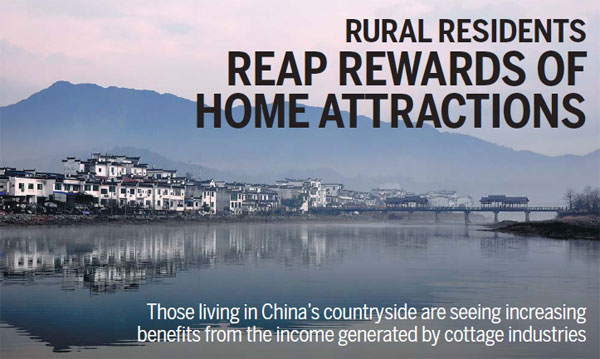Rural residents reap rewards of home attractions
China Daily, August 26, 2016 Adjust font size:

Wuyuan county in East China's Jiangxi province is famed for its well preserved ancient buildings and picturesque villages. Hu Dunhuang / For China Daily
Those living in China's countryside are seeing increasing benefits from the income generated by cottage industries.
A year ago, Zhang Chengde, a villager in Shenshan, Jiangxi province, had no idea that he would be earning an annual salary of 30,000 yuan ($4,527) by renting out his farmhouse.
The tenant is Zhang's daughter and she used the house where her parents had lived for more than half a century to open a nongjiale, or "farmer homestay", where tourists can come and stay and eat locally produced food. Zhang himself opened a store to sell local specialty items.
The father and daughter are among several Shenshan residents who have significant incomes thanks to rural tourism.
More than 30,000 tourists had visited the village by the end of June, and the visitor number for the first half of this year probably exceeded those of past decades, said Huang Chengzhong, the village's Party chief.
He said that when he first visited it 16 years ago, houses in the village were shabby and there was only a narrow road that was unsuitable for vehicles.
Tourism has helped to develop the village, which is now accessible by road. Local farmers are now able to conduct business in a range of areas including nongjiale, tea houses and specialty stores.
The village, which is surrounded by mountains, is developing a range of tourist attractions and integrating them into a new travel route that links the village with nearby attractions such as Huangyangjie historic site, a 1,343-meter-high hill near Jinggang Mountain. It also plans to combine ecological agriculture and tourism, which will enable visitors to pick fruit and vegetables, Huang said.
The city of Ruijin in Jiangxi has also used its tourism resources to alleviate poverty.
Prior to 2012, poverty was rife in Huawu village in the southeastern part of Ruijin because of a lack of resources, infertile land and labor shortages. Back then, 103 out of the 119 households in the village lived in shabby mud brick houses and the village was linked to the outside world by a solitary mud path and an unsafe bridge.
Local people decided that tourism could help lift them out of poverty, and they used "Red" tourism resources related to China's Communist revolution and developed several related scenic spots.
The village also focused on rural tourism and planted different fruits such as grapes and dragon fruit, allowing tourists to participate in the harvest.
The village refurbished and allocated more than 120 unused rooms in the village to accommodate tourists and three of the rooms were in Hua Piyou's family home. Hua said he earned more than 1,000 yuan in one month after the hotel opened in late June.
The development of Huawu is a shining example in Ruijin of how poverty has been alleviated through tourism. The city received 6.15 million visitors last year, a year-on-year rise of 22.5 percent, and its tourism revenue reached 2.25 billion yuan, increasing 25 percent compared with the previous year.
The city has developed more than 20 cultural tourism villages including Zhongtan village in Rentian town and helped nearly 10,000 farmers generate new income streams. Its tourism revenue saw a year-on-year increase of 33.3 percent in the first three months of this year and the service sector centering on travel accounted for 60 percent of its GDP.
Jiangxi in East China has focused largely on poverty relief through tourism in recent years and local officials said the province would focus on ecological, "Red", rural and entertainment tourism to make them a key source of new income for people in poverty-stricken areas.
Some 80 percent of the province's tourism resources are in rural areas and it has 125 traditional Chinese villages and 126 A-level rural tourist destinations.
The Jiangxi Tourism Planning Institute estimated the province has 2,000 villages that are capable of developing rural tourism during the 13th Five-Year Plan period (2016-20). This number accounts for 60 percent of all impoverished villages in the province, and tourism could lift as many as 500,000 local people out of poverty in the period, it said.
If you go
Jiangxi province boasts abundant "Red" tourism resources and the following three tourist routes are especially recommended to help visitors gain a better understanding of the Party's history
Northern route: where the army flag rose
Nanchang, capital of Jiangxi province, is where the August 1 Uprising, the Party's first armed revolt against the Kuomintang, took place. Museums, memorials and the source of the Aug 1 Uprising are well worth a visit and nearby Lushan Mountain provides visitors with stunning natural views.
Western route: the birthplace of the Chinese revolution
In 1927, the leaders of the first administration of the People's Republic of China, including Mao Zedong and Zhu De, founded the first rural revolutionary base area on Jinggang Mountain. About 16 kilometers away is Pingxiang, a city with a history of more than 1,700 years.
This route features Mao's former residence, a cemetery for martyrs and sites of the Autumn Harvest Uprising led by Mao, which is known as one of the three major revolutions in modern Chinese history.
Southern route: the cradle of the republic
The government led by the Party was headquartered in Ruijin from 1931 to 1934, which is known as the former "Red Capital of China". The Red Army's Long March also started from there and visitors can recall the army's exploits while enjoying the city's numerous scenic spots.